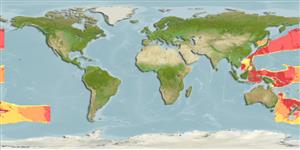Environment: milieu / climate zone / depth range / distribution range
Ecology
Marine; bathypelagic; depth range 892 - 966 m (Ref. 95664). Deep-water
Distribution
Countries | FAO areas | Ecosystems | Occurrences | Point map | Introductions | Faunafri
Western Pacific: Japan and Philippines.
Size / Weight / Age
Maturity: Lm ? range ? - ? cm
Max length : 36.6 cm TL male/unsexed; (Ref. 40777)
Short description
Identification keys | Morphology | Morphometrics
Dorsal spines (total): 0; Dorsal soft rays (total): 17 - 18; Anal spines: 0; Anal soft rays: 14 - 15. Body elongate and subcylindrical. Mouth very large and oblique, maxillary extending below posterior margin of eye. Lower jaw much projected beyond the upper, and provided with a pointed bony knob at symphysis directed forward and downward. Transverse scales very few, about 13 (Ref. 559). Scales deciduous. Pyloric caeca 21 (Ref. 40777).
Collected with an otter trawl (Ref. 95664).
Life cycle and mating behavior
Maturities | Reproduction | Spawnings | Egg(s) | Fecundities | Larvae
Masuda, H., K. Amaoka, C. Araga, T. Uyeno and T. Yoshino, 1984. The fishes of the Japanese Archipelago. Vol. 1. Tokai University Press, Tokyo, Japan. 437 p. (text). (Ref. 559)
IUCN Red List Status (Ref. 130435)
Threat to humans
Harmless
Human uses
Tools
Special reports
Download XML
Internet sources
Estimates based on models
Preferred temperature (Ref.
123201): 3.3 - 3.4, mean 3.3 °C (based on 3 cells).
Phylogenetic diversity index (Ref.
82804): PD
50 = 0.5078 [Uniqueness, from 0.5 = low to 2.0 = high].
Bayesian length-weight: a=0.00347 (0.00164 - 0.00733), b=3.19 (3.00 - 3.38), in cm total length, based on LWR estimates for this (Sub)family-body shape (Ref.
93245).
Trophic level (Ref.
69278): 3.5 ±0.5 se; based on size and trophs of closest relatives
Resilience (Ref.
120179): Medium, minimum population doubling time 1.4 - 4.4 years (Preliminary K or Fecundity.).
Fishing Vulnerability (Ref.
59153): Low to moderate vulnerability (27 of 100).
